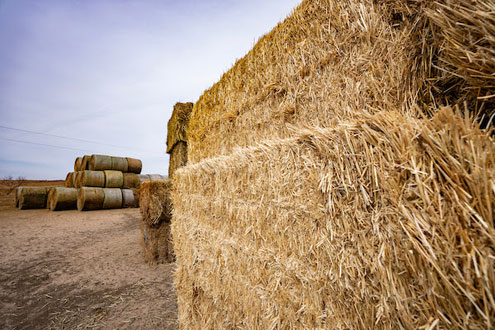Ranchers, forage producers face decisions
as La Niña weather pattern looms
Weather trends toward drought have Texas cattle producers considering their options as cool-season forage planting gets underway.
Much of the state has experienced an extended dry period in recent months. The lack of moisture has left many pastures and fields typically planted with cool-season forages for winter grazing sitting idle as producers wait for rain.
Vanessa Corriher-Olson, Ph.D., AgriLife Extension forage specialist and professor in the Texas A&M Department of Soil and Crop Sciences, Overton, said many East Texas producers are delaying or may not plant cool-season forages due to adequate hay stocks and dry weather.
Corriher-Olson said good spring and summer moisture left many operations with ample hay supplies. As a result, some producers may rely on baled hay rather than risk planting into dry soils.
“I worry that many producers may wait until December or January and then realize their hay quality is low or they could run short,” she said. “At that point, it’s too late for small grains, and their only option would be annual ryegrass.”
Soil moisture levels decline
Jourdan Bell, Ph.D., AgriLife Extension agronomist and associate professor in the Department of Soil and Crop Sciences, Amarillo, said native rangeland looked good for the most part following good summer rains in the Texas High Plains, but conditions are drying in some areas.
Bell said much of the small grains planted in the region are dual-purpose, though more acres are being cut for silage. Producers in the region put up very little perennial hay during the summer. Corn and sorghum silage is cut during the summer for dairies and feedlots, and cool-season forages provide grazing as well as silage that bridges the dietary demands of those livestock.
She recommends producers with decent moisture take advantage and plant as soon as possible.
In South Texas, Josh McGinty, Ph.D., AgriLife Extension agronomist and associate professor in the Department of Soil and Crop Sciences, Corpus Christi, said good summer conditions have also given way to drought. Producers typically plant cool-season forages for grazing or as a rotation crop for cotton.
McGinty said the fields were ready to be planted, but most producers were waiting for rain. The region did not receive any late summer rainfall from the tropical storm season.
“One good region-wide rain could set things off,” McGinty said. “It’s still early for us, so there is no need to dry plant yet, but it is a little concerning that we didn’t catch any significant tropical moisture going into fall and winter.”
Drier, warmer winter La Niña forecast
John Nielsen-Gammon, Ph.D., Texas state climatologist and Regents Fellow in the Texas A&M College of Arts and Sciences Department of Atmospheric Sciences, said conditions for much of the state turned dry in recent months, especially in September. Parts of the state, especially in far West Texas up into the Panhandle, received spotty showers, but that moisture has been declining statewide.
The U.S. Drought Monitor showed summer rains reversed dry conditions across much of the state. On July 1, around 62% of the state reported no level of drought, while the Sept. 30 report showed 63% of the state was experiencing drought. One bright spot is that areas reporting extreme and exceptional levels of drought on July 1 declined during that time.
In the short-term, Nielsen-Gammon said the first half of October looks dry.
His extended forecast predicts a weak La Niña system will persist through the fall and winter months. That means a higher probability of warmer temperatures and fewer chances of rainfall, especially the southern half of Texas.
“A weak La Niña just means the odds of precipitation will tend toward the dry side,” he said. “But it’s really only 3-2 odds, so it looks like a normal winter, a normal recent winter — relatively dry and relatively warm.”

Cool season planting window still open
The window for planting is closing rapidly in some areas, but there are still options for producers hoping to establish forages for winter and early spring.
Corriher-Olson recommends planting cool-season forages about six weeks before the average frost date — typically Nov. 15 in East Texas. While early plantings risk drought stress, later seedings limit forage production potential. Annual ryegrass could be a more flexible option for late plantings, particularly east of Interstate 35, but producers should weigh the costs of seed and fertilizer against expected benefits.
Bell said some areas in the Panhandle still have soil moisture to plant into, but drier areas not planted in the next two weeks will likely be dusted in if rain does not materialize.
Corriher-Olson also urged producers to scout fields for fall armyworms, especially if conditions improve and seedlings emerge. Newly planted annuals are far more vulnerable to damage than established perennial grasses.
“Planting is always a risk,” she said. “But for those who need the forage, getting it in mid- to late October gives the best chance for early growth when it’s needed most.”
Need local, expert advice?
Speak with an AgriLife Extension agent about relevant resources and programs tailored for your county.


